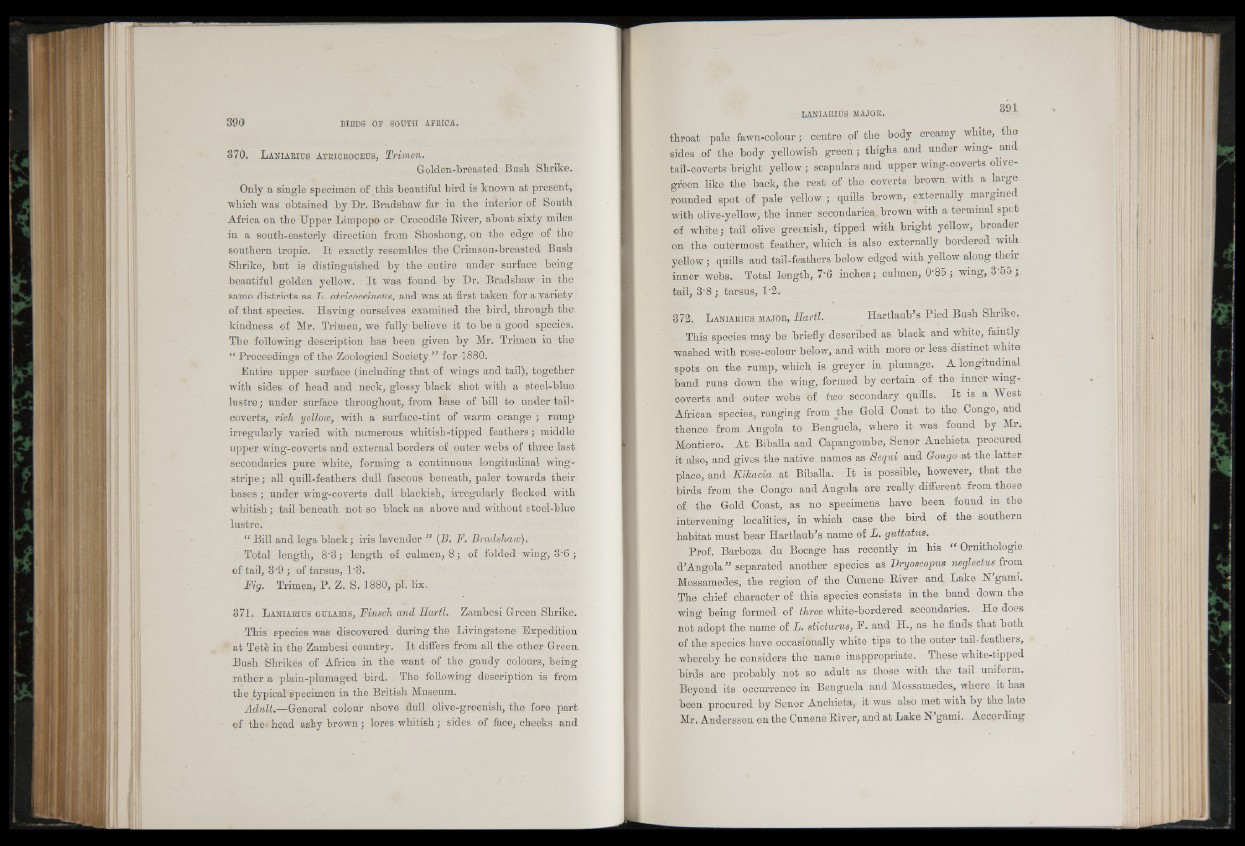
370. L a n i a r i u s a t r i c r o c e u s , Trimen.
Golden-breasted Bush Shrike.
Only a single specimen of this beautiful bird is known at present,
which was obtained by Dr. Bradshaw far in the interior of South
Africa on the Upper Limpopo or Crocodile River, about sixty miles
in a south-easterly direction from Shoshong, on the edge of the
southern tropic. It exactly resembles the Crimson-breasted Bush
Shrike, but is distinguished by the entire under surface being
beautiful golden yellow. It was found by Dr, Bradshaw in the
same districts as L. atncoceineiis, and was at first taken for a variety
of that species. Having ourselves examined the bird, through the
kindness of Mr. Trimen, we fully believe it to be a good species.
The following description has been given by Mr. Trimen in the
“ Proceedings of the Zoological Society ” for 1880.
Entire upper surface (including that of wings and tail), together
with sides of head and neck, glossy black shot with a steel-blue
lustre; under surface throughout, from base of bill to under tail-
coverts, rich yellow, with a surface-tint of warm orange ; rump
irregularly varied with numerous whitish-tipped feathers; middle
upper wing-coverts and external borders of outer webs of three last
secondaries pure white, forming a continuous longitudinal wing-
stripe; all quill-feathers dull fascous beneath, paler towards their
bases; under wing-coverts dull blackish, irregularly flecked with
whitish; tail beneath not so black as above and without steel-blue
lustre.
“ Bill and legs black; iris lavender ” (B. F. Bradshaw).
Total length, 8‘3 ; length of culmen, 8; of folded wing, 3'61
of tail, 3‘9 ; of tarsus, 1'3.
Fig. Trimen, P. Z. S. 1880, pi. lix,
371. L a n i a r i u s g u l a r i s , Finsch and Hartl. Zambesi Green Shrike.
This species was discovered during the Livingstone Expedition
: at Tete in the Zambesi country. It differs from all the other Green.
Bush Shrikes of Africa in the want of the gaudy colours, being
rather a plain-plumaged bird. The following description is from
the typical specimen in the British Museum.
Adult.—General colour above dull olive-greenish, the fore part
of the- head ashy brown ; lores whitish; sides of face, cheeks and
throat pale fawn-colour; centre of the body creamy white, the
sides of the body yellowish green; thighs and under wing- and
tail-coverts bright yellow; scapulars and upper wing-coverts olive-
green like the back, the rest of the coverts brown with a large
rounded spot of pale yellow ; quills brown, externally margined
with olive-yellow, the inner secondaries, brown with a terminal spot
of white; tail olive greenish, tipped with bright yellow, broader
on the outermost feather, which is also externally bordered with
yellow; quills and tail-feathers below edged with yellow along their
inner webs. Total length, 7‘6 inches; culmen, 0’85; wing, 3’55
tail, 3‘8 ; tarsus, 1'2.
372. L a n ia r iu s m a jo r , Hartl. Hartlaub’s Pied Bush Shrike.
This species may be briefly described as black and white, faintly
washed with rose-colour below, and with more or less distinct white
spots on the rump, which, is greyer in plumage. A longitudinal
band runs down the wing, formed by certain of the inner wing-
coverts and outer webs of two secondary quills. It is a West
African species, ranging from the Gold Coast to the Congo, and
thence from Angola to Benguela, where it was found by Mr.
Montiero. At Biballa and Capangombe, Senor Anchieta procured
it also, and gives the native names as Sequi and Gongo at the latter
place, and Kikada at Biballa. It is possible, however, that the
birds from the Congo and Angola are really different from those
of the Gold Coast, as no specimens have been found in the
intervening localities, in which case the bird of the southern
habitat must bear Hartlaub’s name of L. guttatus.
Prof. Barboza du Bocage has recently in his “ Ornithologie
d’Angola” separated another species as Uryoscopus neglectus from
Mossamedes, the region of the Cunene- River and Lake N garni.
The chief character of this species consists in the band down the
wing being formed of three white-bordered secondaries. He does
not adopt the name of L. sticturus, F . and H., as he finds that both
of the species have occasionally white tips to the outer tail-feathers,
whereby he considers the name inappropriate. These white-tipped
birds are probably not so adult as those with the tail uniform.
Beyond its occurrence in Benguela and Mossamedes, where it has
been procured by Senor Anchieta, it was also met with by the late
Mr. Andersson on the Cunene River, and at Lake N garni. According